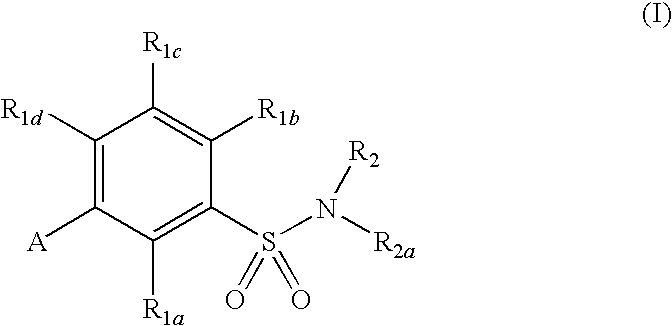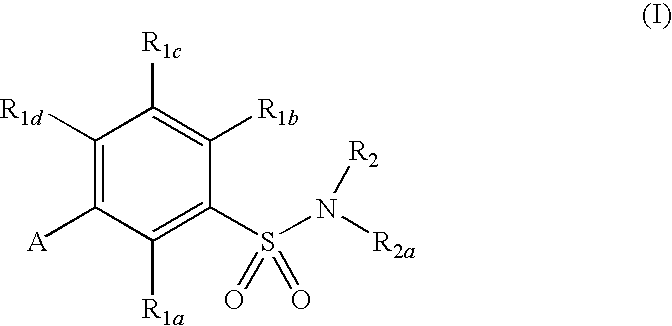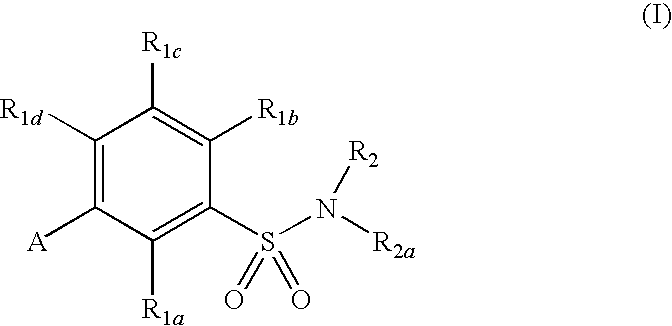Gonadotropin-releasing hormone receptor antagonists and methods relating thereto
a technology of gonadotropin and receptor antagonists, which is applied in the field of gonadotropin-releasing hormone receptor antagonists, can solve the problems of low bioavailability and adverse side effects of peptidic antagonists with low histamine release properties, and the clinical use of such antagonists
- Summary
- Abstract
- Description
- Claims
- Application Information
AI Technical Summary
Benefits of technology
Problems solved by technology
Method used
Image
Examples
example 1
5-Bromo-2-trifluoromethyl-isonicotinonitrile
[0199]
Step 1A: 5-Bromo-2-trifluoromethyl-isonicotinic acid
[0200]To a 100 mL round bottom flask equipped with a rubber septa and nitrogen inlet was charged 5 g (22.1 mmol) of 5-bromo-2-trifluoromethylpyridine. To the solid was charged 30 mL of anhydrous THF under a nitrogen atmosphere. After the solution became homogeneous, it was chilled with a −78° C. dry ice / acetone bath. To a separate 100 mL round bottom flask equipped with a rubber septa and nitrogen inlet was charged 3.4 mL (24.2 mL, 1.1 eq) of anhydrous diisopropyl amine. To the solution was charged 16.9 mL of anhydrous THF, placed under a nitrogen atmosphere and chilled with an ice bath. To the solution was carefully added 9.7 mL (24.3 mmol, 1.1 eq) of 2.5 M n-butyl lithium in hexanes. The light yellow LDA solution was chilled with a −78° C. dry ice / acetone bath. A 100 mL pear shaped flask equipped with a rubber septa, nitrogen inlet, stir bar, thermocouple and double headed cannula...
example 2
4,4-Dimethyl-1,2,3,4-tetrahydro-quinoline
[0219]
Step 2A: 3-Methyl-but-2-enoic acid phenylamide
[0220]To 3,3-dimethylacryloyl chloride (4.8 mL, 43.2 mmol) in dry DCM (100 mL), was added aniline (4.02 g, 43.2 mmol) followed by diisopropylethylamine (14.28 mL, 86.4 mmol). The mixture was stirred at ambient temperature for 2 hrs. Saturated sodium bicarbonate was added to quench the reaction. The organic layer was separated and washed with sat NaHCO3 (50 mL) and water (50 mL×2). The resulting solution was dried over MgSO4 and the filtrate evaporated to afford 3-methyl-but-2-enoic acid phenylamide as a brown solid in quantitative yield (7.6 g). MS: 176.0 (M+H)+; tR=2.40 min (method 1).
Step 2B: 4,4-Dimethyl-3,4-dihydro-1H-quinolin-2-one
[0221]To 3-methyl-but-2-enoic acid phenylamide (7.6 g, 43 mmol) in DCM (100 mL) was added AlCl3(8.7 g, 65.2 mmol) and the mixture was stirred at 50° C. for 2 hrs. After cooling to rt, the mixture was treated with 1N HCl (50 mL) and extracted with DCM (30 mL×2)...
example 3
4-Chloro-5-(4-chloro-6-methyl-pyridin-3-yl)-2-fluoro-N-(2-methoxy-phenyl)-N-methyl-benzenesulfonamide
[0236]
Step 3A: 5-Bromo-4-chloro-2-fluoro-benzenesulfonyl chloride
[0237]1-Bromo-2-chloro-4-fluoro-benzene (25.0 g, 119 mmol) in chlorosulfonic acid (48 mL) was stirred at 95° C. for 2 hrs. After the mixture was cooled to rt, it was added dropwise to ca. 500 mL of ice-water under stirring with the formation of the white precipitations. The filtration of the mixture afforded 5-bromo-4-chloro-2-fluoro-benzenesulfonyl chloride as the white solid (31.5 g) that was used without further purification.
Step 3B: 5-Bromo-4-chloro-2-fluoro-N-(2-methoxy-phenyl)-N-methyl-benzenesulfonamide
[0238]To a solution of DCM (36 mL) containing 5-bromo-4-chloro-2-fluoro-benzenesulfonyl chloride (5.5 g, 17.9 mmol) was added (2-methoxy-phenyl)-methyl-amine (2.6 g, 18.8 mmol) and triethylamine (7.1 mL, 53.7 mmol). The mixture was stirred for 16 hrs. 100 mL of DCM and 100 mL of water were added. The organic layer ...
PUM
 Login to View More
Login to View More Abstract
Description
Claims
Application Information
 Login to View More
Login to View More - R&D
- Intellectual Property
- Life Sciences
- Materials
- Tech Scout
- Unparalleled Data Quality
- Higher Quality Content
- 60% Fewer Hallucinations
Browse by: Latest US Patents, China's latest patents, Technical Efficacy Thesaurus, Application Domain, Technology Topic, Popular Technical Reports.
© 2025 PatSnap. All rights reserved.Legal|Privacy policy|Modern Slavery Act Transparency Statement|Sitemap|About US| Contact US: help@patsnap.com



